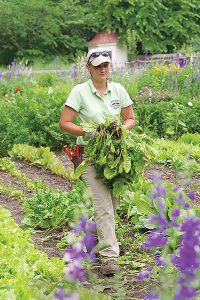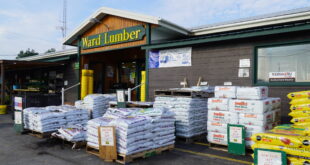In many communities throughout the U.S., there are bastions of preservation, from community parks to certified historical sites. No matter their form, these places require care from experts and support from their local communities to continue operating. Sometimes, caretakers are volunteers who rely on donated tools, while other facilities are maintained by trained professionals who purchase supplies from approved sources.
To learn more about the needs of these spaces, Hardware Retailing spoke to the directors of two public gardens: Becca Turner Ohman, garden director at Garvan Woodland Gardens in Hot Springs, Arkansas; and J. Dean Norton, director of agriculture at Mount Vernon in Mt. Vernon, Virginia. Both institutions represent historical significance in the U.S. and in their local communities, and both employ dozens of caretakers to tend to many acres of gardens, structures and spaces that accommodate hundreds of thousands of tourists each year.
This article explores the needs of these gardens and discusses ways independent home improvement retailers may be able to support public gardens in their own communities and help elevate the value of these spaces.
Horticultural History
As the former home of George Washington, Mount Vernon holds historical significance for Americans. Washington was very involved in the development of the property, taking inspiration from a book called “The New Principles of Gardening,” which started the naturalistic design movement in the late 18th century.

“I have so many primary source documents on the property to refer to,” Norton says. “We have nearly 40 years of Washington’s diaries, and from 1785 to 1786, a day doesn’t pass where he writes about some other trees he’s found or landscape he’s creating. The lawn that people see today is based on the design changes he made during those years.”
Norton says the team at Mount Vernon understands how important it is to maintain the integrity of the property, and having Washington’s notes helps in their decision-making.
“I didn’t study history, but it quickly became a part of my job. Our role is to preserve and protect this place,” he says. “We’re not here to change things. This isn’t my garden, it’s not anybody’s site. It’s George Washington’s.”
In central Arkansas, Garvan Woodland Gardens was donated to the University of Arkansas Fay Jones School of Architecture and Design. The land was previously owned by local businesswoman and philanthropist Verna C. Garvan, who owned a lumber company and a masonry operation. Because of her connection to those industries, and the garden’s affiliation with the architecture school, the site features many structures built out of those materials.
“Architecture is a major component of our mission and what we provide our guests. Interacting with historical and landmark structures inspires and challenges our visitors,” Ohman says.
In 2008, Garvan Woodland Gardens developed a master plan for the entire property, which covers more than 200 acres and includes 4 ½ miles of lakefront. Many structures are laid out in that master plan, including a 650-square-foot, four-level treehouse, a chapel and a pavilion that Verna C. Garvan commissioned from Fay Jones.
“The Garvan Pavilion set the precedent for the materials we use throughout the gardens, including stone, metal and wood elements,” Ohman says.
Up Before the Sun
Because Mount Vernon and Garvan Woodland Gardens function around tourism, most of the work needs to happen before the spaces open, which means early call times for garden staff. The properties open at 9 a.m., so most of the maintenance work happens between 6 a.m. and 9 a.m.
While staying cool on hot summer days is a consideration, one of the primary reasons the staff starts early is to reduce noise pollution for visitors.
“There’s nothing that’s going to ruin the historic setting more than motors,” Norton says.
At Garvan Woodland Gardens, limiting noise is part of the organization’s commitment to preservation.
“Part of our mission is to maintain, preserve and enhance the forest,” Ohman says. “As a component of that, we also try to preserve the guest experience as best we can so they can experience the quiet the gardens provide.”
Preservation and appreciation is part of the daily process at Mount Vernon, too. Each morning starts with the staff of about 15 gardeners and landscapers checking the property for damage or debris and getting it ready for maintenance.
“I try to make sure folks admire their space,” Norton says. “Gardening is the same practices and principles that have been around for centuries. We’re keeping the ongoing routine that Washington’s gardeners would have been doing, too, and there’s something really special about that.”
Tips From the Garden
You can take some cues from the gardeners at Mount Vernon and Garvan Woodland Gardens when it comes to maintaining your operation. Do you have a regular checklist of cleaning and maintenance tasks for your team? When do you complete those tasks? Consider scheduling time for loud or invasive updates during low-traffic times in the store. If you’re constructing a new area or resetting a category, be sure you put up signage explaining any disarray.
Click here for a PDF download outlining cleaning and maintenance tasks for each shift.

Seasonally Relevant
Each garden maintains permanent, perennial flora, such as azaleas throughout Garvan Woodland Gardens, and flower gardens featuring peonies, irises and roses at Mount Vernon. But both spaces take the opportunity to introduce new sections according to the seasons.
At Garvan Woodland Gardens, there are several seasonal highlights throughout the year, including a tulip festival, which features 150,000 tulips and 50,000 other spring bulbs, including hyacinths and daffodils.
During the summer, the core gardens feature a variety of blooms, tropicals and foliage to create a colorful display. In the fall, the garden features mums, pumpkins, gourds and hay bales. While wintertime doesn’t lend itself to new blossoms, the garden does draw visitors with its 18-acre holiday light display.
At Mount Vernon, the kitchen garden was the first George Washington created in 1760. The garden includes fruit trees, berry bushes and leafy greens, which are essentially the same plants that grew during Washington’s time on the property. The Mount Vernon kitchen staff still maintains and harvests the garden throughout the seasons.
Tips From the Garden
Aside from bringing customers into your store to buy seasonal merchandise, how can you attract customers to come see the sights? Make your seasonal displays an experience instead of just another aisle in the store.
Not only will these setups increase impulse buys of seasonal merchandise, but they will also likely inspire word-of-mouth recommendations and create nostalgic memories of your operation for younger shoppers.
Click here to see a photo gallery of different displays in independent home improvement stores.
The Right Kind of Tool
Maintaining more than 700 acres of gardens and land takes a variety of tools, and the staff at Mount Vernon and at Garvan Woodland Gardens has specific preferences and needs.
“We use a wide range of tools, from screwdrivers to heavy equipment, like a mini excavator,” says Ohman. “We have some tulip planters, but we also make them in-house because of the volume of tulips we plant every year.”
A unique aspect of Garvan Woodland Gardens is the rock formations featured on the property. Ohman says the staff uses heavy equipment to position the formations, but they also require rock straps and bars to help maneuver rocks into the right spot.
While the historical value of Mount Vernon isn’t lost on its caretakers, there are some advantages to maintaining an old property with today’s tools.
“We are applying 21st-century technology and tools to an 18th-century setting,” Norton says. “We use whatever tools we need to be efficient at our jobs.”
The staff at Mount Vernon uses all types of power equipment on the property, and quality is a priority. However, some tasks require smaller tools, and that’s OK, Norton says.
“A good hand tool is just as good as a piece of machinery. People have personal preferences on what type of tool they want, so I’m not going to mandate a certain type of pruner.” he says. “As long as it’s done right, that’s what I care about.”
Both Mount Vernon and Garvan Woodland Gardens employ team members with unique, specialized skills. Mount Vernon employs a full-time mechanic, while welders, craftsmen, bricklayers and masons help create and maintain the architectural components at Garvan Woodland Gardens.
“They are a special part of our garden staff. In most cases, gardens aren’t afforded that type of in-house experience,” Ohman says.
Tips From the Garden
If you want your associates to be able to serve anyone who comes into the store, the key is training. A more knowledgeable staff leads to happier customers and stronger employee retention. Make sure everyone on your team can answer questions from novice gardeners taking on a backyard project as well as from experts who take care of historical green spaces like Mount Vernon.
Have your team brush up on their category knowledge with resources on lawn care, pruning tools and more in the Trainer’s Toolbox.

Supporting Public Gardens
Because publicly funded spaces are often required to work with government-approved contractors, there may not be many supplier relationship opportunities. But there are other ways independent home improvement retailers can support public gardens in their communities.
Garvan Woodland Gardens operates a corporate sponsorship program that allows local businesses to become members of the garden through in-kind services and donations.
“Through these partnerships, the business owners and their employees can visit and become part of the community and the culture we offer here,” Ohman says.
Another key way to show support is to encourage attendance and volunteerism, Norton says.
“Some of these sites live and die by volunteer gardeners,” he says. “You would be surprised at the impact of volunteers. If someone reaches out, other people want to get involved and do the same.”
Positioning the value of public gardens is also important.
“When someone sees Mount Vernon, they come away energized,” Norton says. “They want to plant a garden.”
Gardens are also an educational space in addition to being a place of inspiration and respite, Ohman says.
“Beyond the beauty, we are called to provide a learning laboratory for our community and region,” she says. “As we care for and protect our woodland areas, we think that’s a vital opportunity to share.”
Click here to download a PDF of this story.
 Hardware Retailing The Industry's Source for Insights and Information
Hardware Retailing The Industry's Source for Insights and Information








